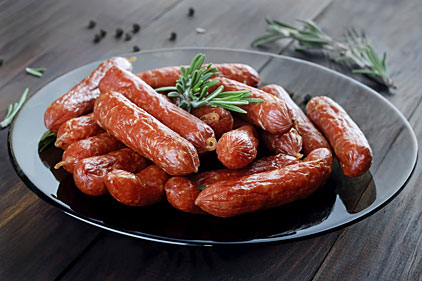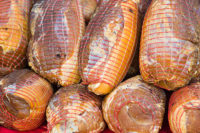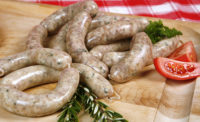If you made a list of packaging types where you are most likely to see the most interesting ideas, I would wager casings would be nowhere near the top. After all, casings are casings, be they collagen, natural, fibrous or whatever. Well, rub your eyes and blink.
Casings are now being coextruded in-line, simultaneously, formed continuously around pumped meat product like fresh sausage. The casings are made from alginate, which is derived from seaweed, processed into a powder and mixed with water to make an aqueous gel or paste. Concurrent to forming the casings, they are treated with calcium chloride. This imparts strength, the proper balance of rigidity and flexibility, and thermal stability.
Let’s pause here. It must be noted this is not just off the drawing board. The process has a solid foundation in Europe. More than half of the casings sold in France are alginate. In what rightly can be called a “mulligan,” the process is getting a second chance for a foothold in North America. According to one industry source, there were a lot of miscues in the introductory approach a few years back that led to a hasty market exit. But that’s a story for another day.
A fair question is what interests processors about alginate casings today? I’m told conversations focus on the expected — cost savings and labor reduction. Apparently, for fresh sausage, alginate can reduce packaging costs between 20 cents and 30 cents per pound compared with collagen casings. When likened to natural casings for the same fresh sausage application, the savings per pound are claimed to be upwards of 50 cents. This is also a continuous process with no labor required for manual stuffing. The casing speed is the same as the meat speed with little or no yield loss. And it’s sustainable.
Physically integrating in-line extrusion into existing processing lines is positioned as being very simple. One source explained the vital components are two hoppers and pumps along with an extrusion nozzle and manifold. The price tag is reportedly around half a million dollars. Those packaging material savings mentioned earlier accrue quickly. One hundred pounds of meat needs only three pounds of alginate gel to form the casings. That’s a material rate of just three percent. A processor making 5 million pounds of sausage annually, a modest amount I’m told, can see a payback in as little as six months, according to that same source.
As you would expect, alginate casings are said to have all of the performance characteristics to ably battle competitors. They can be hung, cut into links, looped, smoked, colored, flavored and have antioxidants added to increase shelf life.
Sources report the alginate process has received positive interest from some prominent processors. The names are attention grabbing. A few are actively testing. Who knows where this goes this time around, but it’s a compelling story and taking a listen costs nothing.








Report Abusive Comment